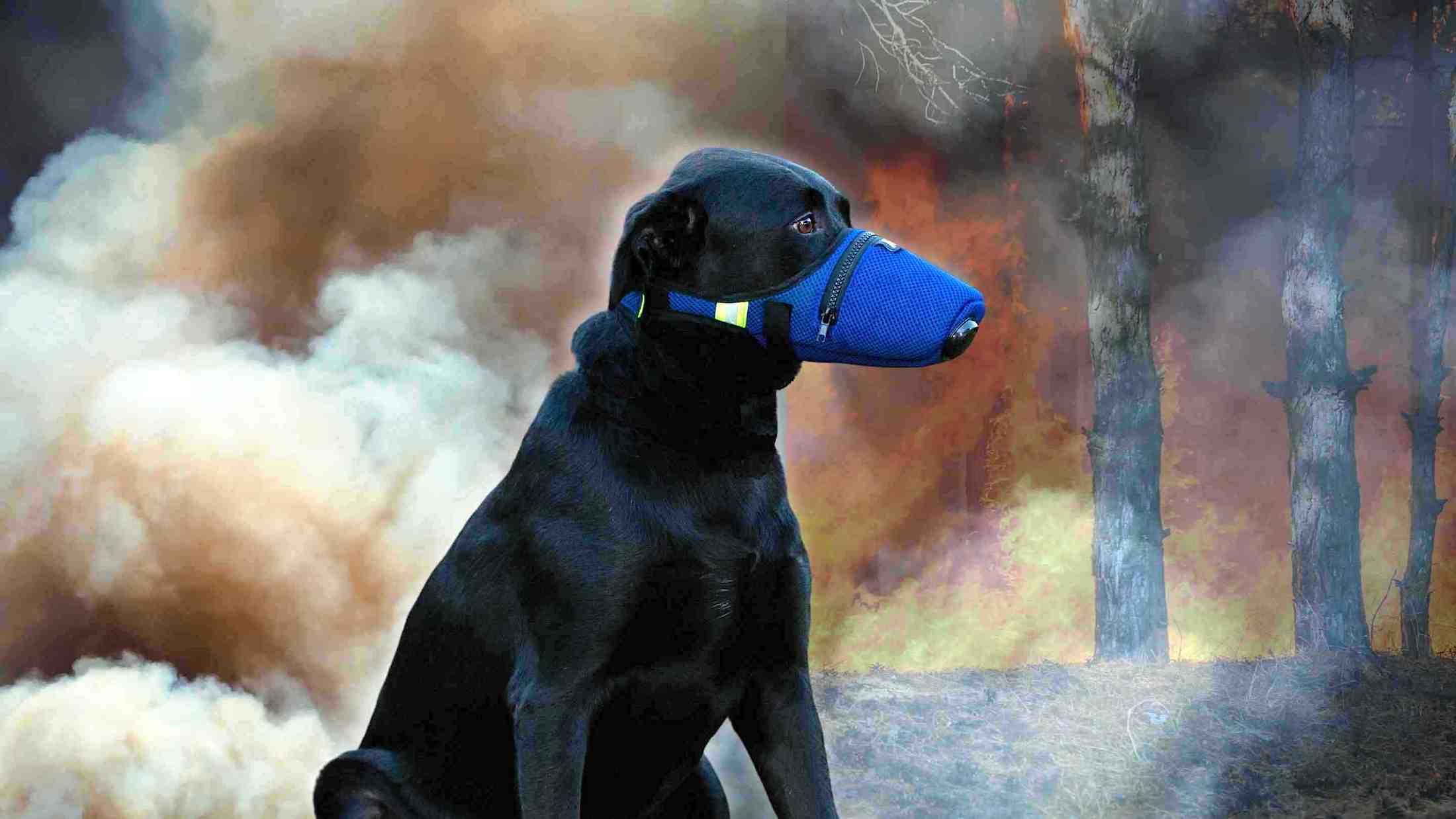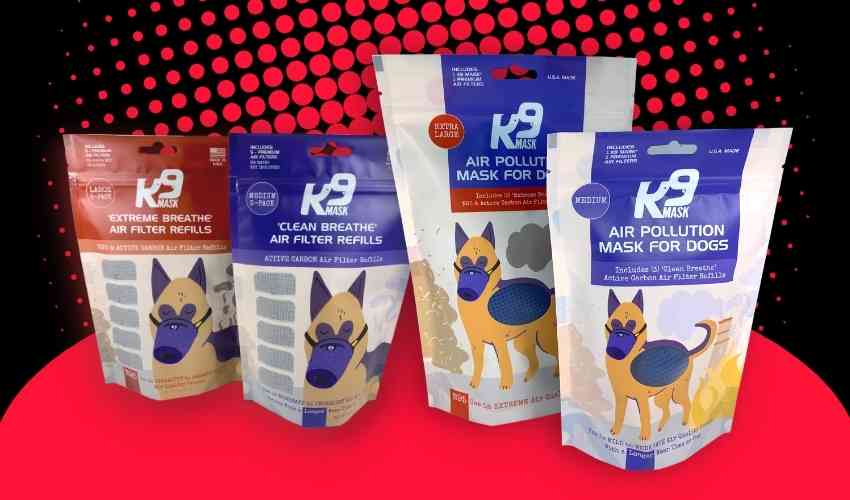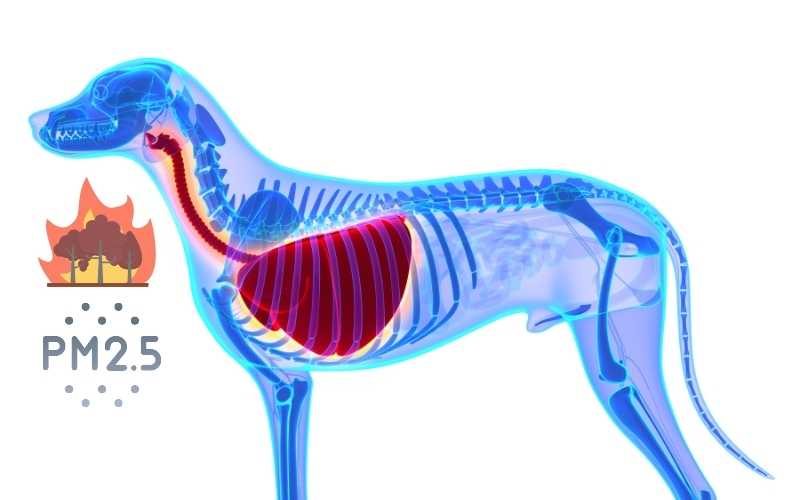With the intense drought we are experiencing in the summer of 2022 there are concerns for wildfires and the resulting smoke. What is the wildfire smoke me and my dog are inhaling doing to our health?
Respiratory Lung and Cardiovascular Heart Systems Affected by Smoke
Respiratory and cardiovascular systems are the first to be affected by wildfire smoke. PM2.5 sinks deep into the lungs and, because it’s so small, can dissolve into the bloodstream. People and pets with preexisting lung or heart conditions are at particular risk for hospitalization or early death after a month of sustained wildfire smoke.
Smoke inhalation injuries can occur with exposure to smoke in large or small quantities. Smoke from fires in urban and rural areas produce a variety of damaging substances, each of which can affect a person or dog's airways, lungs, and heart.

Elements found in smoke inhalation include:
- Carbon monoxide: Carbon monoxide is a colorless, odorless gas that is produced in fires. When carbon monoxide is inhaled and enters the bloodstream, it interferes with the body’s ability to deliver oxygen to organs and tissues.
- Hydrogen cyanide: This substance is released when plastic and other synthetic materials burn. Like carbon monoxide, hydrogen cyanide interferes with the body’s usage of oxygen.
- Chemical irritants: Smoke contains a number of chemical irritants. These irritants can trigger airway inflammation and constriction, as well as other lung damage. The irritants found in smoke may vary, depending on the substances that are being burned.
If the brain is deprived of oxygen due to smoke inhalation, people and pets may show neurologic symptoms. Neurologic symtoms are common with carbon monoxide inhalation. Signs include weakness, ataxia (impaired coordination, or walking as if drunk), seizures, and/or coma. Dogs may drool excessively or vomit. Dogs with carbon monoxide inhalation also tend to develop cherry red discoloration of the gums.
Dogs Vulnerable to Respiratory Distress From Smoke Inhalation
Just as young children and senior citizens are more at risk for harm from breathing wildfire smoke, so too are certain dogs more likely to experience acute illness as a result of poor air quality. These include:
- Any dog with asthma or bronchitis.
- Brachycephalic dogs like bulldogs, Boston Terriers, and Pugs.
- Puppies and senior dogs.

Treating Smoke Inhalation in Pets
The best action to take if you believe your pet has inhaled smoke is to get your dog to a veterinarian as soon as possible. Smoke inhalation is typically treated with oxygen therapy, and the results can be good if the animal is brought in quickly. The earlier the oxygen therapy is applied, the better the prognosis for recovery.
Complications resulting from smoke inhalation may not be immediately apparent, so dog owners should monitor pets closely. Your pet may look OK at first, but some of the dangers occurring in their airways are progressive. Issues can show up quickly, but may also show up days after exposure.
Another effective treatment for smoke inhalation in pets is the use of a hyperbaric chamber. It is essentially an enclosed space that raises air pressure and delivers an increased level of oxygen into the bloodstream. The purpose is to oxygenate the animal's blood to a healthy level.
Pack a Bug Out Bag Emergency Kit For Your Dog
A bug out bag disaster emergency kit should include everything your dog will need in a quick evacuation. Consider your dog’s basic needs, safety, and any medical issues. Keep it in an easy-to-carry waterproof container and store it where you can easily get to it.
Your dog’s kit should include items such as:
- Bottled drinking water (during an emergency, tap water can be contaminated).
- Food in waterproof containers. (Choose pop-top tins or pack a can opener.) Bring enough for at least two weeks.
- Food and water bowls.
- Prescription medications and other required health supplies such as tick medication and heart worm preventative.
- A dog first aid medical kit.
- Poop bags and other clean-up supplies.
- Familiar items like toys, bedding, and blankets to comfort your dog.
- Stress-relieving items like an anxiety vest or calming sprays if your dog is prone to anxiety.

Do Face Masks Protect a Dog Against Smoke?
Many people are aware of wearing face masks to protect themselves from disease, they can also be a tool for protecting us against poor air quality in a wildfire. Air filter smoke masks for dogs like K9 Mask® are effective at protecting a dog from inhaling wildfire smoke.
What are the Safety Warnings for Dogs Wearing an Air Filter Mask?
There are two major concerns for dogs wearing a mask. First, is "Oxygenation." The second, is "Overheating."
Oxygenation:
Is a dog able to breathe through the air filter? Will the dog get enough oxygen through the filter? Does a mask suffocate a dog? These are important questions for the safety of a dog. Dogs need to get enough oxygen to breathe and saturate the blood for proper body function. Using a tool called a 'pulse oximeter' veterinarians are able to test the % amount of oxygen in the blood of a dog. Dogs need higher than 94% of oxygenation in the blood to be healthy. Below this level and the animal is at risk of hypoxia. Hypoxia can cause internal organ disfunction and failure.
For this reason, a dog should only wear an air filter mask for short durations of time. It is also important to maintain visual contact with a dog while it is wearing a mask so that it may be removed immediately if the dog is showing signs of irregular breathing or heaving.
Overheating:
Dogs must pant to release heat from their body so they do not overheat. Panting is the primary method for a dog to cool themselves when it's body temperature increases. Dogs are not able to sweat like a human to cool their body. So, panting is critical for the health of a dog. Will a dog overheat wearing a mask?
At temperatures over 85 degrees Fahrenheit a dog is at risk of overheating. Also, the more active a dog is the higher the internal temperature of the dog will increase. Combine hot temperatures with a dog's increasing internal active temperature and this can create a dangerous situation for a dog.
A dog can overheat causing injury or death to a dog. A dog wearing an air filter mask should be used when going outside for short bathroom breaks or casual walks to stretch their legs.
All of the current air filter masks for dogs have an exhale panting valve built into the mask to release panting air from the mask. These one-way valves allow hot panting air to escape from the mask, and then close when the animal is inhaling through the air filter material around the mask.
This is one solution for masks to help ensure dogs are able to stay cool while wearing the mask. However, this does not mean a dog is out of danger when wearing an air filter mask. The same warnings apply for overheating that apply for oxygenation.
Dog owners should only allow a dog to wear an air filter mask for short durations of time. Dogs wearing an N95 mask should limit the time in the mask to around 10 minutes before taking it off to check on the animals breathing and temperature. It is also important to maintain visual contact with a dog while it is wearing a mask so that it may be removed immediately if the dog is showing signs of overheating.
Some signs of heatstroke are heavy panting, glazed eyes, a rapid heartbeat, difficulty breathing, excessive thirst, lethargy, fever, dizziness, lack of coordination, profuse salivation, vomiting, a deep red or purple tongue, seizure and unconsciousness. Animals are at particular risk for heat stroke if they are very old, very young, overweight, not conditioned to prolonged exercise, or have heart or respiratory disease.
Move your pet into the shade or an air-conditioned area. Apply ice packs or cold towels to their head, neck and chest or run cool (not cold) water over them. Let them drink small amounts of cool water or lick ice cubes. Take them directly to a veterinarian if you are treating your dog for these symptoms of heatstroke.
Protecting Dog Health
These two "O" are important for dog health. Dogs must be properly oxygenated and not overheat. Dogs wearing an air filter face mask have limits.
A dog owner should discern the situation in their location and assess the health threats to themself and their pet when deciding to put a mask on their dog.














